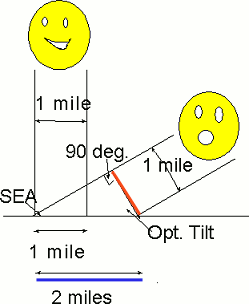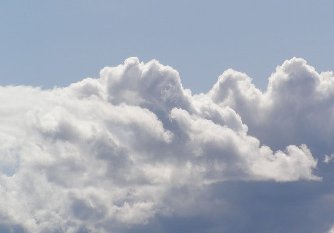
Insolation describes how much sunlight (or solar radiation) a place gets. It is basically a measure of how sunny it is outside.
It is obviously important for solar energy applications but it is also kind of interesting to be able to step outside and have some precise thoughts about how sunny it is.
This page introduces our pages on insolation. We start with the pages that define and explain fundamental concepts. We then give an overview of the factors that most influence insolation and link to the pages that cover those factors in more detail.
This page is one of three introducing fundamental insolation-related ideas.
On insolation definitions we define basic terms and concepts used to talk about solar energy and where the sun is in the sky.
On direct and diffuse radiation we explain the differences between the three types of solar radiation in the sky: direct, diffuse and reflected radiation. We also talk about what percentage of the total radiation in the sky is made up of each of these types of radiation under different circumstances.
For solar energy applications, people are often interested in how to tilt their solar panels or solar collectors.
Tilt angle introduces several pages on this topic.
The rest of this page gives an overview of our pages on the factors that influence how much sunlight falls on a surface.

Not all the 1367 W/m2 ("W/m2" = "watts per square meter") of sunlight that strikes the earth's outer atmosphere each ("daylight") moment makes it down to those of us living on the ground-floor. About 30% of the solar radiation is reflected back into space by the atmosphere. Of the remaining 1,000 W/m2 or so, a given spot on the earth's surface might see about all of it or close to none of it.
The main conditions that influence how much solar energy a place gets during the day are sun angle, air mass, day length, cloud coverage and pollution. This section introduces these topics and links to the pages that cover them in more detail.

If you can't stand introductions, here are the pages:
sun angle,
air mass,
day length, and
clouds and pollution.
If you sort of like
introductions, I also
made the headings into links.
The angle of the sun in the sky changes throughout the day and the general path of the sun through the sky changes throughout the year (the sun's highest point is lower on a winter's day than on a summer's day, etc.).

If the sun is not directly overhead in the sky, the sunlight doesn't strike a horizontal surface directly and this means that it is more "spread-out" over a horizontal surface than it is in the air. This reduces the amount of solar radiation falling on a horizontal surface (like the ground) and is therefore a big part of why winter is colder than summer.
This "spreading-out" problem also impacts solar energy applications but tilting solar collectors properly can compensate for it somewhat and full solar tracking pretty much fixes the problem completely.
We have three pages on this topic. It is recommended that you start with sun angle and insolation intro. That page introduces the general concepts and also introduces the other two pages.
Sa&i data has a table that paints a fairly complete picture of the amount of solar radiation you can expect to receive on a horizontal surface with a given solar angle.
Sa&i formula gives and explains relevant mathematical formulas.
We've decided to introduce "air mass" and "day length" together because they are both predictably related to the sun's path through the sky.
"Air mass" measures how much atmosphere the sunlight has to go through and is greatest when the sun is lowest in the sky. "Day length" is of course how much daylight you get in a 24 hour period and the days are shortest during the winter when the sun is also lowest in the sky.

These factors are similar to each other and different from the "spreading-out" effect discussed previously because they don't just effect how much solar energy falls on a horizontal surface (such as a solar panel laid out flat on the ground).
Their effects are felt before the solar radiation ever reaches the surface of the earth and so no amount of solar-panel-tilting can do anything about them.
Air mass is like the "spreading-out" effect in that it impacts the amount of sunlight falling on a solar panel in a given moment.
Day length is different in this respect because it only impacts the amount of solar energy absorbed by a solar panel over the course of the day - knowing the length of the day won't tell us how much sunlight we're collecting in any given moment.
We have two pages on air mass. Air mass intro gives an overview of the concepts and quantifies how much air mass impacts insolation. Air mass formula explains the formula for calculating air mass. Additionally, one of our pages on Sun Angle and Insolation - sa&i data - shows how air mass contributes to the amount of solar radiation falling on a horizontal surface.
We have one page on day length where we present a table about how day length varies with season and latitude.

The last two conditions influencing insolation levels were similar enough that we put them together on one page: clouds and pollution.
Cloud coverage is just as you'd expect - there's a direct correlation between how cloudy your sky is and how much sunlight you get. On our page, we talk a little bit about how much various levels of cloudiness reduce insolation.
Pollution can also decrease solar radiation anywhere people live but right now it is having the biggest impact on insolation levels over more recently industrialized countries.
If this page has been a help to you
please recommend it with Google+ below:
Page last updated: 02/24/2015
©Copyright 2011. AM Watson & David E. Watson. All rights reserved. Just about everything in the FT Exploring web site is copyrighted. For information concerning use of this material, click on the word Copyright.
Applications author's contact page: Applications Contact.
Disclaimer: All information given on these pages is given in good faith. While we have tried to be accurate, we do not guarantee the accuracy of the information, nor are we liable for any use of the information. If you are undertaking a real-world project, you are responsible for either knowing what you are doing or hiring someone who does.
Hey!
We never interrupt content with ads.
How rare and cool is that these days?!
Help us keep it that way.
Please recommend with the Share button below:
The "not-interrupting-content-as-promised", side links below are not paid ads. They are personal recommendations from David Watson, who is wise and thoughtful:

